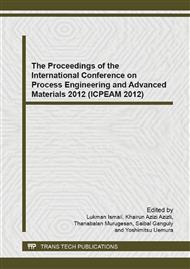p.134
p.144
p.151
p.160
p.168
p.181
p.189
p.199
p.209
UV/H2O2 Process for Removal of Total Organic Carbon from Refinery Effluent: Screening of Influence Factors Using Response Surface Methodology
Abstract:
Effluent containing high concentration of alkanolamine from a sweetening process of natural gas plant is commonly generated during maintaining, cleaning and scheduled inspection of the absorption and desorption column. The effluent is not readily biodegradable and cannot be treated in the conventional biological treatment. Advanced oxidation processes (AOPs) is a promising method for the treatment of recalcitrant organic contaminant. Most methods used are Fenton reagent, UV/Ozone and UV/H2O2. Based on the advantages of the UV/H2O2 such as no formation of sludge during the treatment, high ability in production of hydroxyl radical and applicable in the wide range of pH, the UV/H2O2 has been chosen to treat the effluent from refinery plant, which has high concentration of methyldietnaolamine (MDEA). The factors influencing in the degradation of refinery wastewater that contain MDEA were screened using response surface methodology (RSM). It was found that degradation process of the refinery effluent was highly dependent on oxidant concentration (H2O2) and initial pH. Temperature of oxidation process was found oppositely. Since the temperature gave insignificant effect on the TOC removal process, hence the independent factor temperature will be eliminated during the further optimization process condition of degradation. Thus, the optimization process condition of degradation will be more effective and simpler.
Info:
Periodical:
Pages:
168-177
Citation:
Online since:
June 2014
Keywords:
Price:
Сopyright:
© 2014 Trans Tech Publications Ltd. All Rights Reserved
Share:
Citation:


